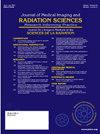智能降噪软件对骨盆数字x线摄影图像质量的影响幻影研究。
IF 1.3
Q3 RADIOLOGY, NUCLEAR MEDICINE & MEDICAL IMAGING
Journal of Medical Imaging and Radiation Sciences
Pub Date : 2024-12-06
DOI:10.1016/j.jmir.2024.101814
引用次数: 0
摘要
本研究旨在评估一种新型降噪软件(INR,佳能欧洲,阿姆斯特丹,NL)对数字放射摄影(DR)骨盆幻象图像质量(IQ)的影响。方法:共收集53张盆腔幻影图像和360张CDRAD技术图像,包括8种不同的暴露水平(0.8 - 40 ma, 70 kV)和6种INR强度(设置0-10)。骨盆图像由三名报告放射技师使用绝对视觉分级分析(VGA)进行评估。用CDRAD计算机软件对CDRAD图像进行分析。结果:VGA显示,使用INR软件的图像比未使用INR软件的图像具有更高的智商。观察者对INR为3.2 mAs或更高的图像给出了很高的VGA评分。有一种趋势是5或7的INR水平给出最高的VGA分数。此外,CDRAD的研究表明,在较低的暴露水平下,随着INR水平的提高,智商也有显著提高。结论:当在VGA和CDRAD研究中同时使用INR软件时,在较低的暴露水平下可以看到总体智商的提高。在实践中实施INR之前,需要进行包括患者图像在内的临床试验,以验证准确的诊断性能。本文章由计算机程序翻译,如有差异,请以英文原文为准。
How does intelligent noise reduction software influence the image quality in pelvic digital radiography; a phantom study
Introduction
This study aims to evaluate the effects of a novel noise reduction software (INR, Canon Europe, Amsterdam, NL) on image quality (IQ) in Digital Radiography (DR) pelvic phantom images.
Methods
In total, 53 pelvic phantom images and 360 technical images of a Contrast Detail Radiography phantom (CDRAD) were collected, including 8 different exposure levels (between 0.8 and 40 mAs at 70 kV) and 6 intensities of INR (ranging from settings 0–10). The pelvic images were evaluated by three reporting radiographers using absolute Visual Grading Analysis (VGA). The CDRAD images were analyzed with a CDRAD computer software.
Results
The VGA showed that the images with the INR software had higher IQ than the images with no INR. The observers gave a high VGA score to the images with INR of 3.2 mAs and higher. There was a tendency for an INR level of 5 or 7 to give the highest VGA scores. In addition, the CDRAD study showed a significant improvement in IQ with increasing INR levels at the lower exposure levels.
Conclusion
An improvement in overall IQ was seen at lower exposure levels when the INR software was used both for the VGA and the CDRAD study. Clinical tests including patient images need to be performed before implementing INR in practice to verify accurate diagnostic performance.
求助全文
通过发布文献求助,成功后即可免费获取论文全文。
去求助
来源期刊

Journal of Medical Imaging and Radiation Sciences
RADIOLOGY, NUCLEAR MEDICINE & MEDICAL IMAGING-
CiteScore
2.30
自引率
11.10%
发文量
231
审稿时长
53 days
期刊介绍:
Journal of Medical Imaging and Radiation Sciences is the official peer-reviewed journal of the Canadian Association of Medical Radiation Technologists. This journal is published four times a year and is circulated to approximately 11,000 medical radiation technologists, libraries and radiology departments throughout Canada, the United States and overseas. The Journal publishes articles on recent research, new technology and techniques, professional practices, technologists viewpoints as well as relevant book reviews.
 求助内容:
求助内容: 应助结果提醒方式:
应助结果提醒方式:


